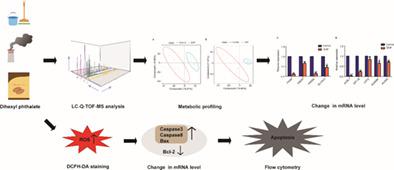当前位置:
X-MOL 学术
›
Environ. Toxicol.
›
论文详情
Our official English website, www.x-mol.net, welcomes your
feedback! (Note: you will need to create a separate account there.)
Combining metabolomics with bioanalysis methods to investigate the potential toxicity of dihexyl phthalate
Environmental Toxicology ( IF 4.4 ) Pub Date : 2020-10-12 , DOI: 10.1002/tox.23027 Dan Song 1, 2 , Chao Xu 1 , Askild L. Holck 3 , Rong Liu 1, 4, 5
Environmental Toxicology ( IF 4.4 ) Pub Date : 2020-10-12 , DOI: 10.1002/tox.23027 Dan Song 1, 2 , Chao Xu 1 , Askild L. Holck 3 , Rong Liu 1, 4, 5
Affiliation

|
Dihexyl phthalate (DHP) is one of the most commonly used phthalate esters in various plastic and consumer products. Human are inevitably exposed to DHPs. Although several animal and human experiments have revealed that DHP can cause multiple toxicities, few studies have previously assessed the effects of DHP exposure by liquid chromatography mass spectrometry (LC‐MS) analysis combine with molecular biology methods on human cells. Therefore, the purpose of our study was to investigate the effect of DHP on human cell metabolism by systems biology methods. In this study, U2OS cancer cells were treated with 10 μM DHP for metabolomics analysis and apoptosis analysis at indicate time. Metabolomic study of the metabolic changes caused by DHP in U2OS cells was performed for the first time using integrative liquid chromatography coupled with quadrupole time‐of‐flight mass spectrometry (LC‐Q‐TOF‐MS). To investigate the possible reason of fatty acids level altered by DHP, we measured some key fatty acid synthesis and oxidation‐related enzyme expression levels by quantitative real‐time PCR (Q‐PCR). Apoptotic cells were analyzed by flow cytometry and apoptosis‐related gene expressions were measured by Q‐PCR. 2′,7′‐Dichlorofluorescein diacetate (DCFH‐DA) staining was used to evaluate ROS content. Partial least squares‐discriminate analysis (PLS‐DA) clearly showed that significant differences in metabolic profiles were observed in U2OS cells exposed to DHP compared with controls. A total of 58 putative metabolites in electrospray ionization source (ESI) + mode and 32 putative metabolites in ESI‐mode were detected, the majority of the differential metabolites being lipids and lipid‐like molecules. Among them, the altered fatty acids level corresponded to expression levels of genes encoding enzymes related to fatty acids synthesis and oxidation. Moreover, DHP induced reactive oxygen species (ROS) accumulation, promoted cell apoptosis and inflammation, and resulted in a significant increase in apoptosis and inflammation‐related gene expression levels compared with controls. In summary, our results suggested that metabolomics combined with molecular bioanalysis methods could be an efficient tool to assess toxic effects, which contribute to explore the possible cytotoxicity mechanisms of DHP, and provide a basis for further research.
中文翻译:

将代谢组学与生物分析方法相结合,研究邻苯二甲酸二己酯的潜在毒性
邻苯二甲酸二己酯 (DHP) 是各种塑料和消费品中最常用的邻苯二甲酸酯之一。人类不可避免地会接触到 DHP。尽管一些动物和人体实验表明 DHP 可引起多种毒性,但此前很少有研究通过液相色谱质谱 (LC-MS) 分析结合分子生物学方法评估 DHP 暴露对人体细胞的影响。因此,我们研究的目的是通过系统生物学方法研究 DHP 对人体细胞代谢的影响。在本研究中,U2OS 癌细胞在指定时间用 10 μM DHP 处理用于代谢组学分析和细胞凋亡分析。首次使用集成液相色谱结合四极杆飞行时间质谱(LC-Q-TOF-MS)对 U2OS 细胞中 DHP 引起的代谢变化进行代谢组学研究。为了研究 DHP 改变脂肪酸水平的可能原因,我们通过定量实时 PCR (Q-PCR) 测量了一些关键的脂肪酸合成和氧化相关酶的表达水平。通过流式细胞术分析凋亡细胞,并通过 Q-PCR 测量凋亡相关基因的表达。2',7'-二氯荧光素二乙酸酯 (DCFH-DA) 染色用于评估 ROS 含量。偏最小二乘判别分析 (PLS-DA) 清楚地表明,与对照组相比,暴露于 DHP 的 U2OS 细胞的代谢特征存在显着差异。在电喷雾电离源 (ESI) + 模式下总共检测到 58 种推定代谢物,在 ESI 模式下检测到 32 种推定代谢物,大多数差异代谢物是脂质和脂质类分子。其中,改变的脂肪酸水平对应于编码与脂肪酸合成和氧化相关的酶的基因的表达水平。此外,与对照组相比,DHP 诱导活性氧 (ROS) 积累,促进细胞凋亡和炎症,并导致细胞凋亡和炎症相关基因表达水平显着增加。总之,我们的结果表明,代谢组学结合分子生物分析方法可以成为评估毒性作用的有效工具,有助于探索 DHP 可能的细胞毒性机制,
更新日期:2020-10-12
中文翻译:

将代谢组学与生物分析方法相结合,研究邻苯二甲酸二己酯的潜在毒性
邻苯二甲酸二己酯 (DHP) 是各种塑料和消费品中最常用的邻苯二甲酸酯之一。人类不可避免地会接触到 DHP。尽管一些动物和人体实验表明 DHP 可引起多种毒性,但此前很少有研究通过液相色谱质谱 (LC-MS) 分析结合分子生物学方法评估 DHP 暴露对人体细胞的影响。因此,我们研究的目的是通过系统生物学方法研究 DHP 对人体细胞代谢的影响。在本研究中,U2OS 癌细胞在指定时间用 10 μM DHP 处理用于代谢组学分析和细胞凋亡分析。首次使用集成液相色谱结合四极杆飞行时间质谱(LC-Q-TOF-MS)对 U2OS 细胞中 DHP 引起的代谢变化进行代谢组学研究。为了研究 DHP 改变脂肪酸水平的可能原因,我们通过定量实时 PCR (Q-PCR) 测量了一些关键的脂肪酸合成和氧化相关酶的表达水平。通过流式细胞术分析凋亡细胞,并通过 Q-PCR 测量凋亡相关基因的表达。2',7'-二氯荧光素二乙酸酯 (DCFH-DA) 染色用于评估 ROS 含量。偏最小二乘判别分析 (PLS-DA) 清楚地表明,与对照组相比,暴露于 DHP 的 U2OS 细胞的代谢特征存在显着差异。在电喷雾电离源 (ESI) + 模式下总共检测到 58 种推定代谢物,在 ESI 模式下检测到 32 种推定代谢物,大多数差异代谢物是脂质和脂质类分子。其中,改变的脂肪酸水平对应于编码与脂肪酸合成和氧化相关的酶的基因的表达水平。此外,与对照组相比,DHP 诱导活性氧 (ROS) 积累,促进细胞凋亡和炎症,并导致细胞凋亡和炎症相关基因表达水平显着增加。总之,我们的结果表明,代谢组学结合分子生物分析方法可以成为评估毒性作用的有效工具,有助于探索 DHP 可能的细胞毒性机制,











































 京公网安备 11010802027423号
京公网安备 11010802027423号